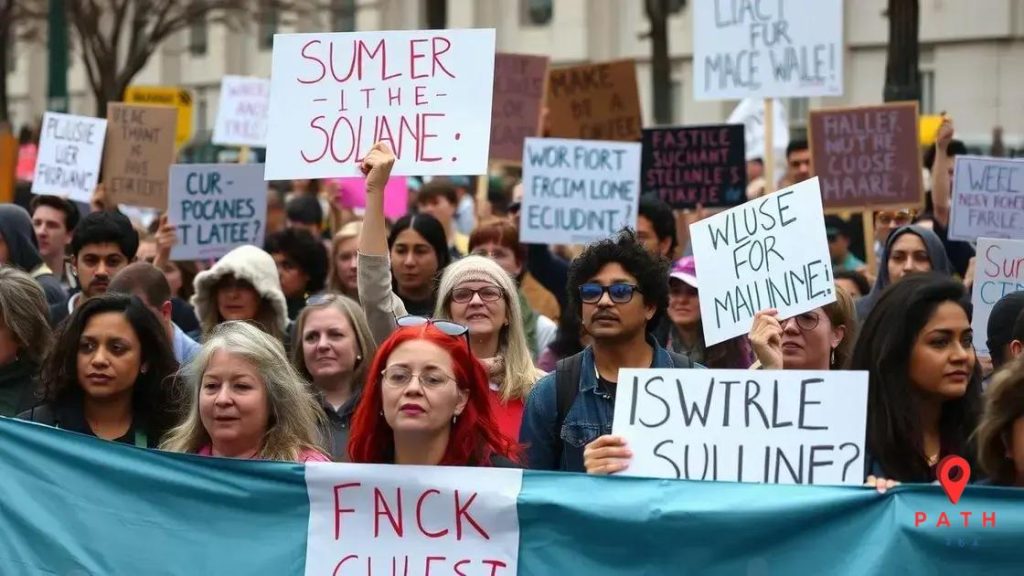Social justice protests 2025: a turning point for change

Anúncios
Social justice protests in 2025 focus on sustainability, utilizing modern technology, engaging communities, and drawing inspiration from influential figures, aiming for long-term solutions to pressing social issues.
Social justice protests 2025 have taken center stage, igniting passion and drawing attention worldwide. Have you noticed how these movements shape policies and perspectives today? Let’s dive into their significance.
Anúncios
The emergence of grassroots movements
The emergence of grassroots movements has played a vital role in driving social change. These movements often begin within local communities, mobilizing ordinary people to address issues that affect their lives.
Grassroots activism enables individuals to voice their concerns and demand action from authorities. By uniting for a common cause, these movements can influence public opinion and policy.
Anúncios
Key Characteristics of Grassroots Movements
Grassroots movements typically share several key characteristics:
- Community Focus: They are rooted in local issues, ensuring that the voices of the community are heard.
- Volunteer-Driven: These movements rely on volunteers, fostering a sense of ownership and commitment among participants.
- Social Media Utilization: They often leverage social media platforms to spread awareness and organize events efficiently.
For more in-depth insights, check out the National Institutes of Health, which discusses the impact of grassroots movements on public health and policy.
Key issues driving social justice protests in 2025
Understanding the key issues driving social justice protests in 2025 is essential for grasping the current landscape of activism. Various factors are at play, each sparking waves of movements across the globe.
One major issue is racial inequality, which continues to ignite protests as communities demand equal treatment and justice. Alongside this, economic disparities have prompted calls for better wages and working conditions for all.
Other Notable Areas of Focus
Protesters in 2025 are also focusing on:
- Climate Justice: Activists urge governments to take decisive action against climate change and hold corporations accountable.
- Gender Equality: Movements advocating for women’s rights are demanding equal representation and an end to gender-based violence.
- LGBTQ+ Rights: Supporters are pushing for protections and recognition of LGBTQ+ individuals’ rights across various nations.
For more information on these pressing issues, visit the Human Rights Campaign.
The role of technology in modern activism

The role of technology in modern activism is transformative and essential. Today, activists use various digital tools to amplify their messages and connect with supporters globally.
Social media platforms have become crucial for organizing events, sharing stories, and raising awareness. Through #hashtags, movements can quickly spread and gain traction.
Key Contributions of Technology
Technology contributes significantly to activism in several ways:
- Information Sharing: Instant access to news and information helps keep communities informed and engaged.
- Community Building: Online forums and groups allow activists to form connections and share resources effectively.
- Fundraising Tools: Crowdfunding platforms make it easier for movements to raise funds for their causes, ensuring financial support for initiatives.
For more insights on technology’s impact on advocacy, visit the Center for American Progress.
Influential figures in the social justice landscape
Influential figures in the social justice landscape have shaped movements and driven change. These individuals often inspire others and lead by example, advocating for vital causes.
Activists, scholars, and community leaders play critical roles in raising awareness about issues that matter. Many have harnessed the power of social media to amplify their messages and reach wider audiences.
Notable Advocates
Some key figures include:
- Martin Luther King Jr.: An iconic leader in the civil rights movement, his nonviolent approach inspired generations.
- Malala Yousafzai: A global advocate for girls’ education, she survived an attack for speaking out against injustice.
- Angela Davis: A scholar and activist focused on racial justice, gender equality, and prison abolition.
For a deeper understanding of their impact, visit the NAACP, which highlights the ongoing struggle for civil rights and justice.
The future of protest: sustainable impact
The future of protest is poised to create a sustainable impact on society and the environment. As movements evolve, they increasingly focus on long-lasting solutions rather than just temporary fixes.
Today’s activists emphasize a holistic approach, integrating various issues like social justice, climate change, and economic equality into their agendas. This interconnectedness helps build a stronger coalition for change.
Strategies for Sustainable Protests
To ensure lasting effects, protests can adopt several key strategies:
- Community Engagement: Involving local communities fosters ownership and a deeper commitment to issues.
- Education and Awareness: Teaching the public about ongoing issues drives informed participation and support.
- Collaborative Efforts: Partnering with other organizations expands resources and strengthens the movement.
For ideas on sustainable practices in activism, check out the Earth Day Network, which promotes environmental awareness and action.